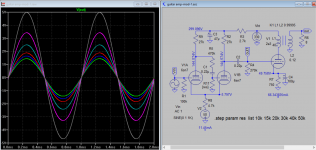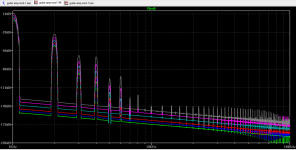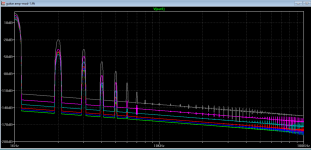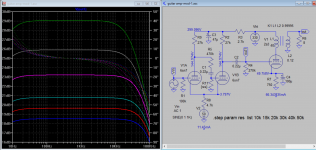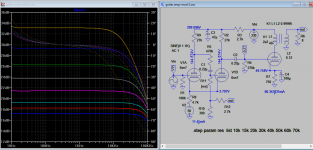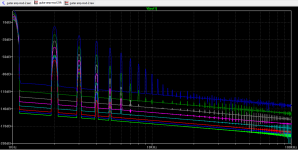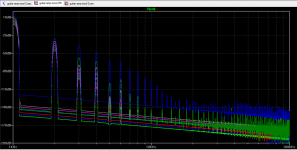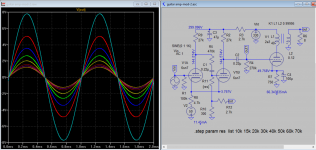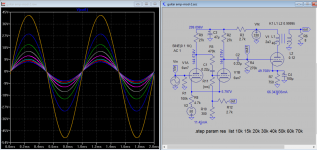Now that I remember, the Japanese design with a 6sn7 amplifying into another 6sn7 section is aiming at removing the 6sn7 tube character.
well, ok. but if the original design is SRPP, it could be converted to a Mu-Follower with relative ease...
The Mu-Follower had superbly low distortion, and lower gain. You could take the output from the bottom of the upper triode (what most do), or from the top of lower triode for a bit less gain (what almost nobody does).
I think if you daisy-chain two differential amplifiers you will find the result will be louder, and it won't drive the 2a3 as well as SRPP, which has lower output impedance. A Mu-Follower will be even better... up to you. good luck!
The Mu-Follower had superbly low distortion, and lower gain. You could take the output from the bottom of the upper triode (what most do), or from the top of lower triode for a bit less gain (what almost nobody does).
I think if you daisy-chain two differential amplifiers you will find the result will be louder, and it won't drive the 2a3 as well as SRPP, which has lower output impedance. A Mu-Follower will be even better... up to you. good luck!
Last edited:
well, ok. but if the original design is SRPP, it could be converted to a Mu-Follower with relative ease...
The Mu-Follower had superbly low distortion, and lower gain. You could take the output from the bottom of the upper triode (what most do), or from the top of lower triode for a bit less gain (what almost nobody does).
I think if you daisy-chain two differential amplifiers you will find the result will be louder, and it won't drive the 2a3 as well as SRPP, which has lower output impedance. A Mu-Follower will be even better... up to you. good luck!
Well, the previous ideas were just based on suggestions from others on this forums. I would need to learn more about what does what on every pin of the 6SN7 and read up on mu followers before I can discuss this with you or try it for myself. Any examples would be appreciated.
I found this adapter, but it does not look like it fits the 6SN7 socket. Which adapters did you use?
I think I found your setup. Looks like a custom job.
Sorry for the delay in responding.
Yes, I modified mine so that they would fit next to one another on my VTA SP-14 preamp.
If you do an Ebay search for 2C22 to 6SN7 you will find the correct adapter.
This one works:
http://www.ebay.com/itm/1pc-Dual-6C...519526?hash=item2c995c3b26:g:LdUAAOSwyQtVlRuP
Sorry for the delay in responding.
Yes, I modified mine so that they would fit next to one another on my VTA SP-14 preamp.
If you do an Ebay search for 2C22 to 6SN7 you will find the correct adapter.
This one works:
1pc Dual 6C8P 2C22 7193 CV6 CV3601 to 6SN7GT B65 CV1988 Tube Converter Adapter | eBay
But how much lower gain can I expect when using two 2C22 per one 6SN7?
6SN7 and 2C22/E-1148/7193 gain are both listed at 20, but I found the output of the 2C22 to be much less than the 6SN7. Less than 1/2 I would say.
Sorry to hear what happened, but with your effort and the help of this forum hopes the trouble would soon be over. So here is another idea. Despite this is LPT, but the even harmonics are not canceled.
Attachments
This is NFB version, with no loss of gain and harmonics.
Attachments
Last edited:
Thanks for simulating the circuit again. I read that the NFB can give unstable highs and lows. What is LPT? I think I need another explanation what you did here. You named the files guitar amp mod - it is a not a guitar amplifier. The source is a minidsp 4x10HD digital crossover unit.
Thanks for simulating the circuit again. I read that the NFB can give unstable highs and lows. What is LPT? I think I need another explanation what you did here. You named the files guitar amp mod - it is a not a guitar amplifier. The source is a minidsp 4x10HD digital crossover unit.
LTP Long Tail Pairs, must be spelling, never mind about the file name, you said before it can use for guitar amp that is why I name it, now for hf-fi only, whatever use is no harm. Maybe good for acoustic guitar, with the amp will have even harmonics dominating, if build as such.
Unstable high and low? Not really. the only thing unstable is the output transformer, here the feedback is only quite low. It's not just NFB, positive feedback also use, that is why there is no loss of gain. I use PFB and NFB together for a long time in hi-fi amp, the harmonics are well controlled as you see from the plot. There is one version I mentioned which uses only PF, and the gain is controlled by the amount of PF. I don't think you and not many other have tried PF before, it has been used in several commercial amp such Dynaco ST70 and phone pre-amp. PF can undo the bad effect of NFB such as creation of odd harmonics.
One thing you may have noticed in the sim in the NFB version is the shift of distortion to driver from output stage. The driver stage has about 5% distortion or pre-distorted correction for output stage to get it down to 0.8% at full power. The sim has revealed the weakness in the output stage, maybe that is why it's suspected, as it has not able to optimize the performance using the existing circuit because it has no mean of correction and no obvious pre-distortion correction, this is that my main concern for your amp. Some drivers I sim found them to have some fixed pre-distorted drive, with NFB it's dynamic. If you have other problems let me know. My sim maybe not be correct unless your verified it and I'll not send any more version. The weakness could be in hardware as well, but adding dynamic corrections are big plus.
Last edited:
Okay, I can try to make it at least and see how it sounds. I only need the passive components since I have the tubes and transformers already.
Interesting that you found a weakness in my current preamp, or at least a very similar version of it. Could be part of why I don't like it as it is.
I will build it and see how your versions sound. Will take a few weeks.
Interesting that you found a weakness in my current preamp, or at least a very similar version of it. Could be part of why I don't like it as it is.
I will build it and see how your versions sound. Will take a few weeks.
You can also simply add a 'power soak' or resistor attenuator between amp and speaker to get the volume down but keep the higher working amplifier sound - not ideal, I now, but a quick fix.
Is there any other type of 7193 than the KenRad manufactured ones?
Is there any other type of 7193 than the KenRad manufactured ones?
You can also simply add a 'power soak' or resistor attenuator between amp and speaker to get the volume down but keep the higher working amplifier sound - not ideal, I now, but a quick fix.
Is there any other type of 7193 than the KenRad manufactured ones?
Well--Sure!
Ive read through ten pages of complicated discussions, rebuild suggestions new tubes all sorts!--When All thats needed is simple!
Switch the Volume Pot From the Input of the amp--To The Output!
More properly, get say a 10-15 ohm 10W Wirewound pot and wire this to the Output of the amp to which the Speaker is connected.--Use This to get the level of sound required.
Doing so, the Output valve can be driven into clipping--but sound pressure level in the room can be from 0 to loud enough!
Simplest ideas are always best.😀
- Status
- Not open for further replies.
- Home
- Amplifiers
- Tubes / Valves
- 6SN7 preamp tube alternative with less gain?

